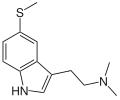
5-MeS-DMT

| |
| Names | |
|---|---|
|
Preferred IUPAC name
N,N-Dimethyl-2-[5-(methylsulfanyl)-1H-indol-3-yl]ethan-1-amine | |
| Other names
5-Methylthio-N,N-dimethyltryptamine
| |
| Identifiers | |
|
3D model (JSmol)
|
|
| ChEMBL | |
| ChemSpider |
|
|
PubChem CID
|
|
| UNII | |
|
CompTox Dashboard (EPA)
|
|
| |
| |
| Properties | |
| C13H18N2S | |
| Molar mass | 234.36 g·mol−1 |
|
Except where otherwise noted, data are given for materials in their standard state (at 25 °C [77 °F], 100 kPa).
| |
5-MeS-DMT (5-methylthio-N,N-dimethyltryptamine) is a lesser-known psychedelic drug. It is the 5-methylthio analog of dimethyltryptamine (DMT). 5-MeS-DMT was first synthesized by Alexander Shulgin. In his book TiHKAL (Tryptamines I Have Known and Loved), the minimum dosage is listed as 15-30 mg. The duration listed as very short (less than one hour), just like DMT. 5-MeS-DMT produces similar effects to DMT, but weaker. Shulgin describes his feelings while on a low dose of this drug as "pointlessly stoned", although at a higher dose of 20 mg he says it is "quite intense" and suggests that a higher dose still might have full activity.
5-MeS-DMT has been the subject of only limited clinical testing, with several small behavioral studies in rats indicating that it is a less potent than 5-MeO-DMT or 4-hydroxy-DMT (psilocin) but more effective than either 4-MeO-DMT or 4-MeS-DMT.